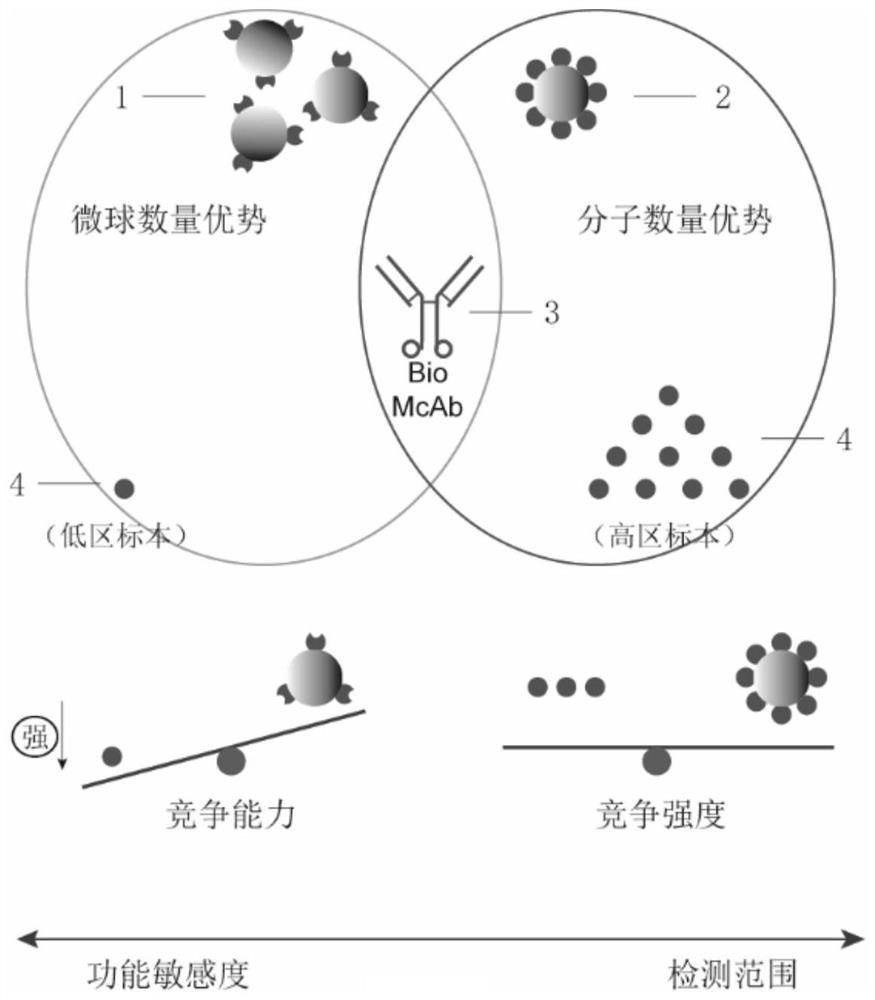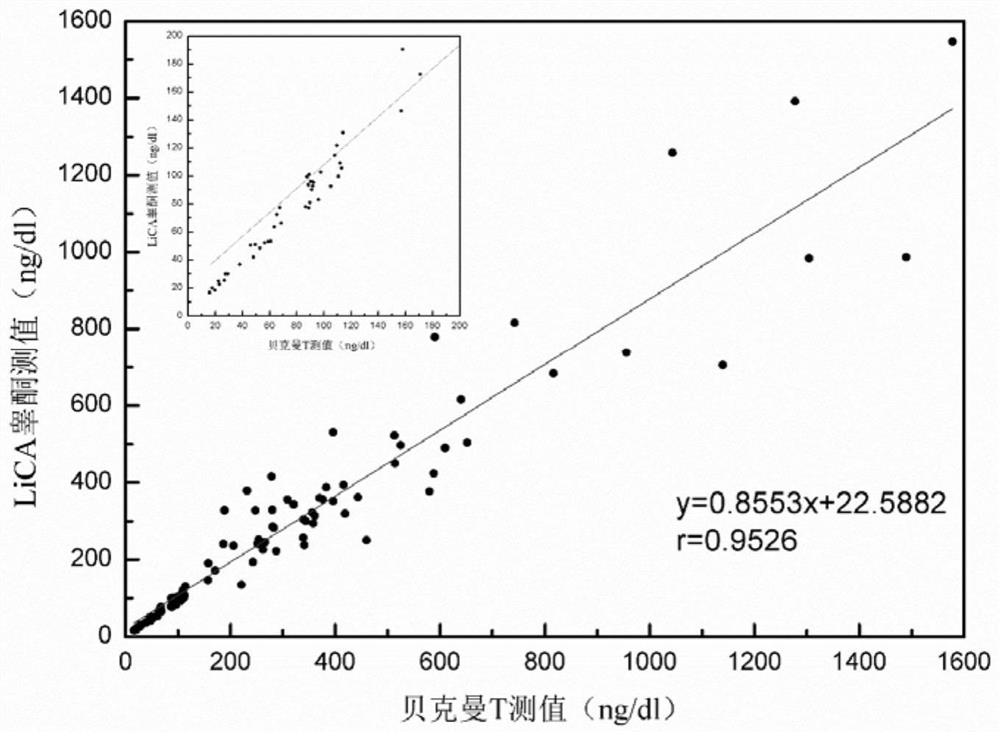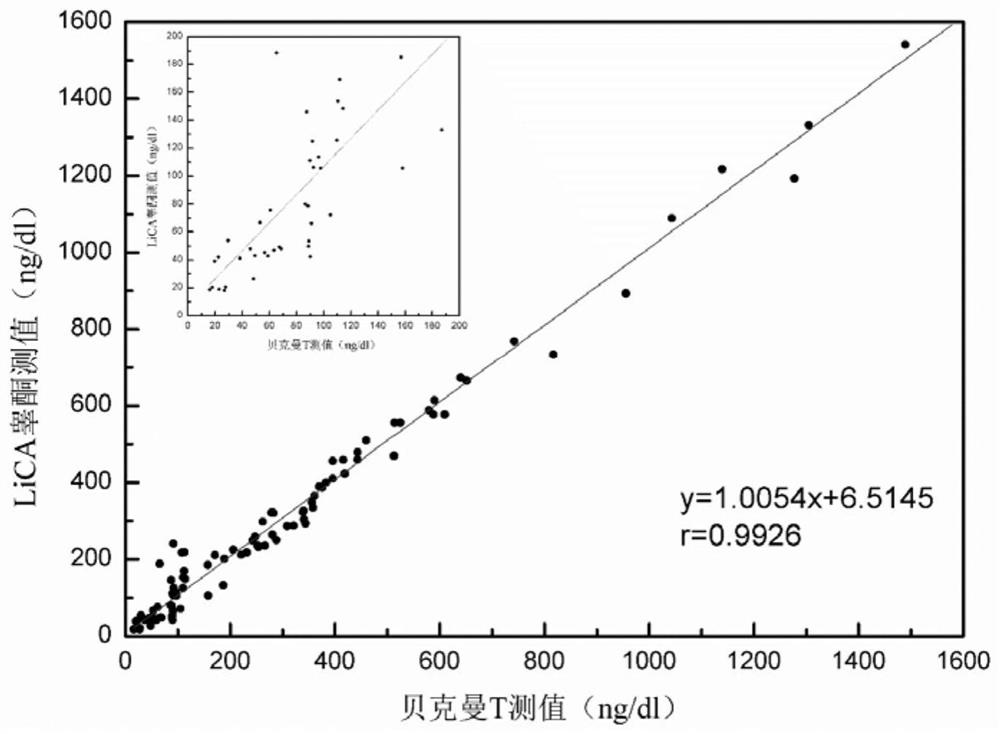Competitive homogeneous chemiluminescence detection method and application thereof
A homogeneous chemiluminescence and detection method technology, which is applied in the direction of chemiluminescence/bioluminescence, analysis by making materials undergo chemical reactions, and measurement devices, can solve the problems of not being able to effectively balance functional sensitivity and analysis range, and achieve broadened detection Effects of range, prevention of hook effects, high precision and accuracy
- Summary
- Abstract
- Description
- Claims
- Application Information
AI Technical Summary
Problems solved by technology
Method used
Image
Examples
Embodiment 1
[0088] Embodiment 1: the preparation of the reagent used for the method of the present invention that the analyte is testosterone Reagent and instrument:
[0089] Testosterone Antibody Conjugated to Biotin, Receptor Microspheres, BSAylated Dihydrotestosterone (BSA-DHT), BSAylated Testosterone (BSA-T), Phosphate Buffer (0.02M PBS, pH 7.2), BSA, Tween-20, LiCA 500 (Beijing Kemei Biotechnology Co., Ltd.), Hitachi high-speed refrigerated centrifuge.
[0090] making process:
[0091] (1) Preparation of competitive antigen-coupled receptor microsphere solution (reagent 1)
[0092] 1) Take 2 mg of receptor microspheres from two 2 mL centrifuge tubes, centrifuge at 10,000 rpm at 4°C for 15 min, and wash once.
[0093] 2) Ultrasonic dispersion is uniform, add 0.2mg BSA-T to one of the centrifuge tubes, add 0.02mg BSA-DHT to the other, mix well and coat overnight at 4°C;
[0094] 3) Add 20uL 10mg / mL BSA-blocked receptor microspheres to two centrifuge tubes, and rotate at room tempera...
Embodiment 2
[0104] Utilize R1-1, R1-2, R1-3 prepared in Example 1 respectively as the method of reagent 1 to detect the sample containing testosterone, and the detection result is compared with the Beckman measured value, and the results are respectively as follows Figure 2-4 shown.
[0105] The detection process is automatically completed by the LiCA500 automatic light-induced chemiluminescence analysis system and the detection results are output. The specific steps are:
[0106] a. Add 20 μl of sample, calibrator or quality control to the reaction well;
[0107] b. Add 20 μl release agent, 25 μl reagent 1 and 25 μl reagent 2 to the reaction well in sequence;
[0108] c. Incubate at 37°C for 15 minutes;
[0109] d. Add 175 μl of LiCA universal solution (donor microsphere solution combined with avidin);
[0110] e. Incubate at 37°C for 15 minutes;
[0111] e. Laser irradiates microholes and calculates the amount of photons emitted per hole;
[0112] f. According to the calibration c...
Embodiment 3
[0114] Embodiment 3: precision detection
[0115] Intra-batch precision detection: use the reagents, high, middle and low samples adopted by the method of the present invention to carry out precision detection: every batch of reagents is measured 10 times, and the mean value X and standard deviation SD of 10 measurement results are calculated, according to the formula CV=SD / X×100% to get the coefficient of variation CV. The results are shown in Table 1 and Table 3.
[0116] Inter-batch precision detection: use three batches of reagents used in the method of the present invention to detect high, middle and low samples respectively, repeat 10 times, calculate the mean value X and standard deviation SD of 30 measurement results, according to the formula CV=SD / X× 100% yields a coefficient of variation, CV. The results are shown in Table 2 and Table 3.
[0117] Table 1: Raw data of intra-assay precision of LiCA T reagent (photo-induced chemiluminescence method)
[0118]
[...
PUM
 Login to View More
Login to View More Abstract
Description
Claims
Application Information
 Login to View More
Login to View More - R&D
- Intellectual Property
- Life Sciences
- Materials
- Tech Scout
- Unparalleled Data Quality
- Higher Quality Content
- 60% Fewer Hallucinations
Browse by: Latest US Patents, China's latest patents, Technical Efficacy Thesaurus, Application Domain, Technology Topic, Popular Technical Reports.
© 2025 PatSnap. All rights reserved.Legal|Privacy policy|Modern Slavery Act Transparency Statement|Sitemap|About US| Contact US: help@patsnap.com



